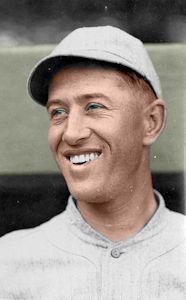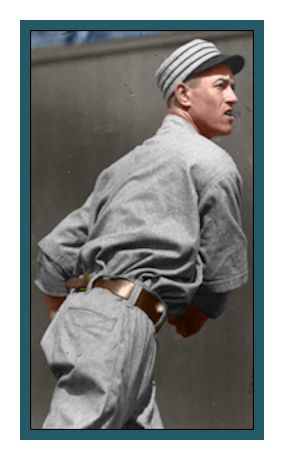|
“FENWAY'S BEST PLAYERS”  |
|||||
At the age of 13, Joe Bush played some third base for the Brainerd, Minnesota town team. His first important game as a pitcher was in 1911, in relief against the St. Cloud team. He struck out 11 men that day, won all of his starts that summer, and never looked back. The Missoula, Montana, club of the Union Association (Class D) signed Joe to a contract for the 1912 season. There he learned to pitch and threw with great velocity, generally being compared with the best speed-ball pitchers of the day like Walter Johnson. That year Missoula won the the Union Association championship, and Joe posted a league-leading 26-16 record. Connie Mack purchased Joe from the Missoula team and he made his debut with the A's in September. The next year, in 1913 as a starter, he won 15 of 21 decisions in the regular season. He then shut down the New York Giants in the third game of the 1913 World Series and the baseball world took notice. But that win over the Giants would be one of only two victories in seven World Series decisions for him. Bush had another good year with the Athletics in 1914 as part of a strong staff that led the team into the 1914 World Series once again but against the "Miracle Braves" from Boston. The A's had lost the first two games in Philadelphia. Joe was given the pitching assignment for Game #3, but this time the result was different. In the 12th inning with runners on first and second, Joe threw a bunted ball away, allowing the winning run to score. The reigning champion Philadelphia A's were crushed when the Braves won the next game and made a clean sweep of the World Series. Connie Mack then began to dismantle his club selling off star players rather than compete in a bidding war with the Federal League. The A's were woeful, plummeting the basement in 1915. The same ineptness that characterized the A's in that year continued in both 1916 and 1917. Despite little run support and a poor defense behind him, Joe still won 15 games, with a remarkable 2.57 ERA. In 1917, he improved his ERA to 2.47, despite an 11-17 won-loss record. Cash-strapped Connie Mack dispensed with three more members of his once-great teams that December, dealing Bush, Wally Schang, and Amos Strunk to the Red Sox for three undistinguished players, and $60,000. All three ex-Athletics would contribute to the Red Sox in their run for the pennant in 1918, especially Joe Bush. He managed a 15-15 won-loss record and a career-best 2.11 ERA, including seven shutouts and a team-high 125 strikeouts. Bush, Babe Ruth, Carl Mays, Sad Sam Jones, and Dutch Leonard formed the strong pitching corps that led the Red Sox into the 1918 World Series. Joe appeared in two games, losing Game #2, a well-pitched 3-1 contest, and saved a win for pitcher Babe Ruth in Game #4. It would be the last World Series won by the Red Sox for 86 years. The following year was a difficult one for Joe. He developed arm trouble and remained out of action most of the season. It appeared that he was all but washed, but his toughness and indefatigable spirit sustained him and pushed him to a comeback year with the Red Sox the next season. But the 1920 Red Sox bore no resemblance to the champions of 1918. Like Connie Mack, Sox owner Harry Frazee needed cash and had begun to dismantle his championship team. Once again Joe found himself on a team that had won a championship and now was in the process of being sold off. The Red Sox became mired in mediocrity, finishing 1921 in fifth place, but Joe had a good year, with a 16-9 won-loss record and a 3.50 ERA also batting .325 In December 1921, Frazee continued to break up the Red Sox by sending Bush, along with shortstop Everett Scott, to the Yankees. There he joined Babe Ruth and a strong Yankees club that would go on and win multiple American League pennants.
|
|||||

